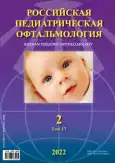Long-term treatment as chorioretinitis of atypical optic disk pit complicated by retinal detachment in the macular zone
- Authors: Katargina L.A.1, Denisova E.V.1, Osipova N.A.1
-
Affiliations:
- Helmholtz National Medical Research Center of Eye Diseases
- Issue: Vol 17, No 2 (2022)
- Pages: 45-52
- Section: Case reports
- URL: https://journals.rcsi.science/1993-1859/article/view/105649
- DOI: https://doi.org/10.17816/rpoj105649
- ID: 105649
Cite item
Abstract
Changes in the macular zone of the retina, which have different etiopathogenesis, can occur with a similar ophthalmoscopic picture.
AIM: To present the clinical case of a child with a congenital the optic disc pit, complicated by retinal detachment in the macular zone, who received long-term treatment for chorioretinitis.
RESULTS: A 13-year-old child was referred to the Helmholtz National Medical Research Center for a diagnosis of an idiopatic chorioretinal inflammation in the right eye. For 2 years at home, the child received inpatient treatment, including anti-inflammatory, desensitizing, and antibacterial therapy, without changes in visual acuity, ophthalmoscopy, and optical coherence tomography (OCT) data. Based on a comprehensive assessment of OCT results of the macular area and the optic nerve head (presence of a peripapillary slit-like detachment of the neuroepithelium in the superior temporal and inferior temporal quadrants, detachment of the neuroepithelium in the macula), anamnesis (lack of a “response” to ongoing anti-inflammatory therapy), biomicroscopy, and ophthalmoscopy (on the right, the optic disc is oval, horizontally elongated, decolorized, along the horizontal meridian it is made of glial tissue, in the area of the papillomacular bundle and in the macula, there is a rough redistribution of pigment. On the left, the optic disc is oval, horizontally elongated, decolorized, the macula and the periphery without pathology), the diagnosis was made: a congenital anomaly in the development of the optic disc (optic disc pit) in both eyes complicated by retinal detachment in the macula on the right. The child underwent transpupillary laser coagulation of the retina in the parapapillar zone in the upper and lower temporal quadrants of the right eye. Upon further observation after 1 and 2 months, OCT data revealed positive dynamics of resorption of the subretinal fluid in the macular zone, and an increase in visual functions was noted.
CONCLUSION: Сompetent interpretation and integration of the results of clinical and instrumental examinations and thorough analysis of anamnestic data make it possible to identify the pathology underlying structural disorders of the macular zone, which is of key importance in choosing the right treatment techniques and maintaining visual functions.
Full Text
##article.viewOnOriginalSite##About the authors
Lyudmila A. Katargina
Helmholtz National Medical Research Center of Eye Diseases
Email: katargina@igb.ru
ORCID iD: 0000-0002-4857-0374
MD, PhD, Dr. Sci. (Med.), Professor
Russian Federation, MoscowEkaterina V. Denisova
Helmholtz National Medical Research Center of Eye Diseases
Email: deale_2006@inbox.ru
ORCID iD: 0000-0003-3735-6249
SPIN-code: 4111-4330
MD, PhD
Russian Federation, MoscowNatalya A. Osipova
Helmholtz National Medical Research Center of Eye Diseases
Author for correspondence.
Email: natashamma@mail.ru
ORCID iD: 0000-0002-3151-6910
SPIN-code: 5872-6819
MD, PhD
Russian Federation, MoscowReferences
- Georgalas I, Ladas I, Georgopoulos G, Petrou P. Optic disc pit: a review. Graefes Arch Clin Exp Ophthalmol. 2011;249(8):1113–1122. doi: 10.1007/s00417-011-1698-5
- Chatziralli I, Theodossiadis P, Theodossiadis GP. Optic disk pit maculopathy: current management strategies. Clin Ophthalmol. 2018;12:1417–1422. doi: 10.2147/OPTH.S153711
- Gass JDM. Serous detachment of the macula secondary to optic disc pits. Am J Ophthalmol. 1969;67(6):821–841.
- Theodossiadis G. Evolution of congenital pit of the optic disk with macular detachment in photocoagulated and nonphotocoagulated eyes. Am J Ophthalmol. 1977;84(5):620–631. doi: 10.1016/0002-9394(77)90375-0
- Theodossiadis GP, Theodossiadis PG, Ladas ID, et al. Cyst formation in optic disc pit maculopathy. Doc Ophthalmol. 1999;97(3–4):329–335. doi: 10.1023/a:1002194324791
- Sugar HS. An Explanation for the Acquired Macular Pathology Associated with Congenital Pits of the Optic Disc. Am J Ophthalmol. 1964;57:833–835.
- Irvine AR, Crawford JB, Sullivan JH. The pathogenesis of retinal detachment with morning glory disc and optic pit. Retina. 1986;6(3):146–150. doi: 10.1097/00006982-198600630-00002
- Jain N, Johnson MW. Pathogenesis and treatment of maculopathy associated with cavitary optic disc anomalies. Am J Ophthalmol. 2014;158(3):423–435. doi: 10.1016/j.ajo.2014.06.001
- Gowdar JP, Rajesh B, Giridhar A, et al. An insight into the pathogenesis of optic disc pit-associated maclopathy with enhanced depth imaging. JAMA Ophthalmol. 2015;133(4):466–469.
- Turkcuoglu P, Taskapan C. The Origin of Subretinal Fluid in Optic Disc Pit Maculopathy. Ophthalmic Surg Lasers Imaging Retina. 2016;47(3):294–298. doi: 10.3928/23258160-20160229-15
- Dithmar S, Schuett F, Voelcker HE, Holz FG. Delayed sequential occurrence of perfluorodecalin and silicone oil in the subretinal space following retinal detachment surgery in the presence of an optic disc pit. Arch Ophthalmol. 2004;122(3):409–411. doi: 10.1001/archopht.122.3.409
- Kuhn F, Kover F, Szabo I, Mester V. Intracranial migration of silicone oil from an eye with optic pit. Graefes Arch Clin Exp Ophthalmol. 2006;244(10):1360–1362. doi: 10.1007/s00417-006-0267-9
- Yuen CH, Kaye SB. Spontaneous resolution of serous maculopathy associated with optic disc pit in a child: a case report. J AAPOS. 2002;6(5):330–331. doi: 10.1067/mpa.2002.127921
- Parikakis EA, Chatziralli IP, Peponis VG, et al. Spontaneous Resolution of Long-Standing Macular Detachment due to Optic Disc Pit with Significant Visual Improvement. Case Rep Ophthalmol. 2014;5(1):104–110. doi: 10.1159/000362263
- Akca Bayar S, Sarigul Sezenoz A, Yaman Pinarci E, Yilmaz G. Spontaneous Regression of Optic Disc Pit Maculopathy in a Six-Year-Old Child. Turk J Ophthalmol. 2017;47(1):56–58. doi: 10.4274/tjo.57614
- Abouammoh MA, Alsulaiman SM, Gupta VS, et al. Pars plana vitrectomy with juxtapapillary laser photocoagulation versus vitrectomy without juxtapapillary laser photocoagulation for the treatment of optic disc pit maculopathy: the results of the KKESH International Collaborative Retina Study Group. Br J Ophthalmol. 2016;100(4):478–483. doi: 10.1136/bjophthalmol-2015-307128
- Teke MY, Citirik M. 23 Gauge Vitrectomy, Endolaser, and Gas Tamponade Versus Vitrectomy Alone for Serous Macular Detachment Associated With Optic Disc Pit. Am J Ophthalmol. 2015;160(4):779–785 e772. doi: 10.1016/j.ajo.2015.07.019
- Lei L, Li T, Ding X, et al. Surgical. Options for Optic Disc Pit Maculopathy: Perspectives and Controversies. Eye (Lond). 2015;29(1):106–114.
Supplementary files












